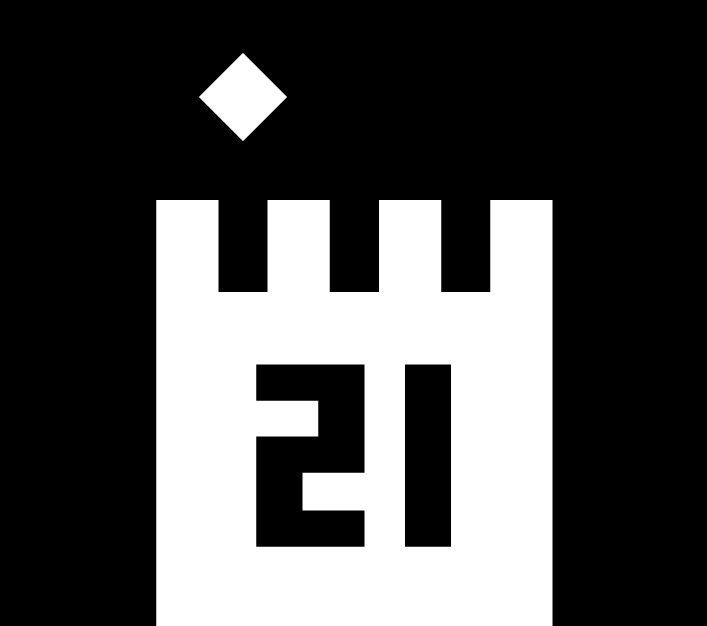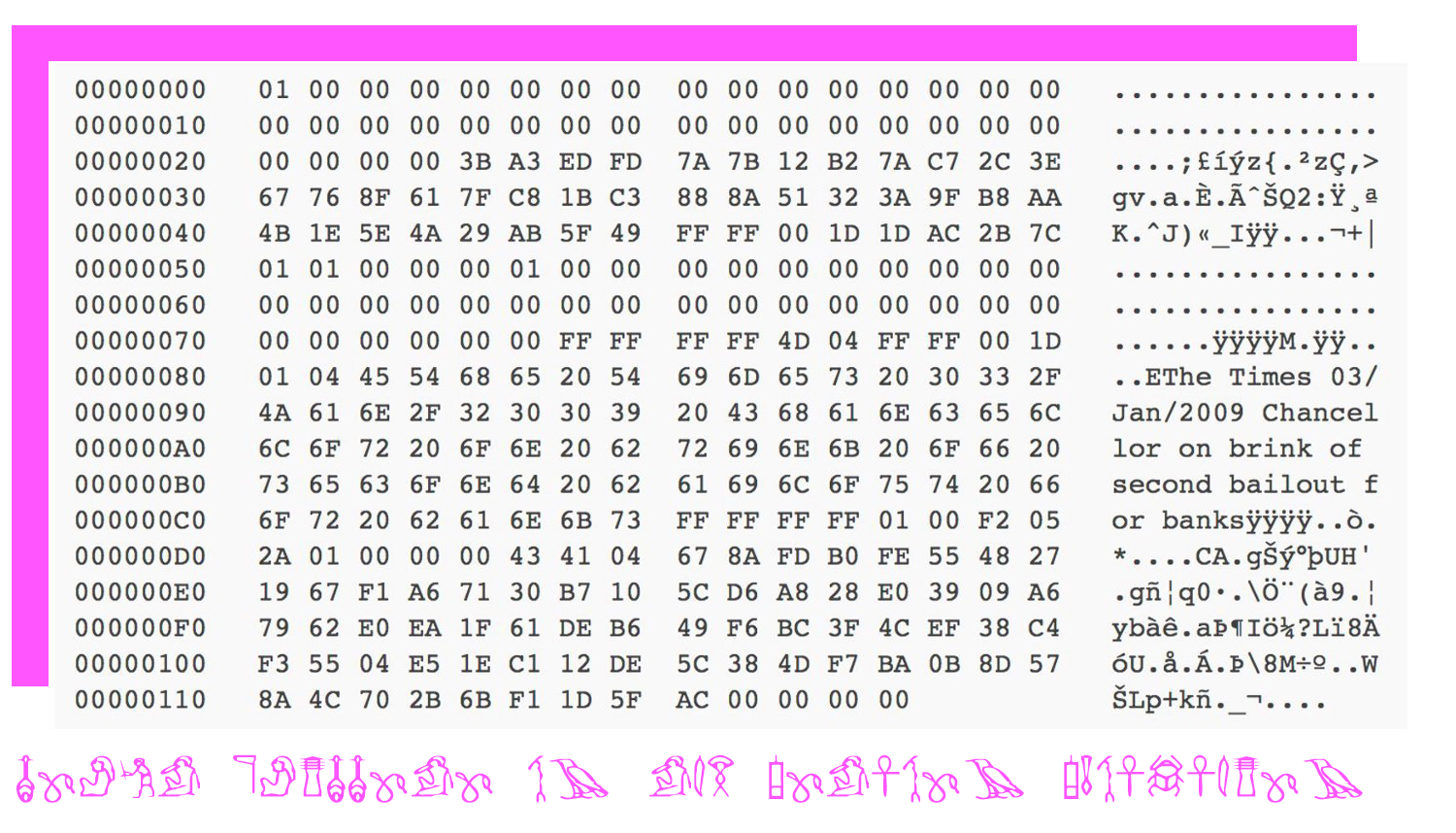Bitcoin Hieroglyphics
Etching the blockchain for immortality
by Bitcoin Graffiti | Jan. 21st, 2022 | vol.15
Credits: hodlxhold
Graffiti comes from the Italian graffiato which means to scratch or etch a surface. It has been used over the ages to create messages and tell stories on public property. This art form includes Egyptian hieroglyphics, murals, ancient cave writings, spray painting, etc..
With the advent of digital property, a new form of graffiti has come into being. The first digital graffiti was scribbled onto the Bitcoin blockchain by none other than Satoshi Nakamoto himself. “The Times 03/Jan/2009 Chancellor on brink of second bailout for banks” is a political statement engraved on the foundational block of the ledger. Many others have since put their message onto this new digital wall. Like Egyptian hieroglyphs, it takes some effort to find and decrypt them.
So what mysterious messages have as of yet been engraved onto the blockchain? And how does a Bitcoin graffiti etcher write to the ledger?
First graffiti on the Bitcoin blockchain
How to etch?
The Bitcoin protocol leaves some space in order to insert data other than transactional data into the ledger. Nodes verify new transactions, that need to adhere to certain rules. Therefore, it’s not as simple as just inserting your message into a transaction, as it will be rejected by the network. Wallets other than Bitcoin Core won’t provide you with the ability of designing custom transactions, therefore all digital graffiti has to be done by running your own node and writing your own code.
The most common way to do Bitcoin graffiti is using the OP_RETURN operator. A transaction output contains a Script part that normally does the logic on checking whether the public key and the signature are derived from the same private key. Instead, by using the OP_RETURN operator, we can include a custom message. These UTXOs therefore don’t have a valid locking script and are not addressed to anybody. The amount of satoshis can be 0, but the whole transaction will of course require a mining fee to be included.
The website mempool.space automatically deocodes any ASCII encrypted data from coinbases and OP_RETURNs is visible without custom data parsing. For example, Charley and Heidi declared their love at block height 308570.
The size of OP_RETURN data is limited. The allowed space used to be bigger, but was reduced in order to prevent ‘vandalism’. So for larger messages the data will need to be split over multiple outputs.
Next to the OP_RETURN method, simply swapping out a Bitcoin address for data in the outputs (e.g. the Sassaman tribute) has been done frequently.
ASCII encryption is the simplest digital graffiti method for conveying a message easily readable by others. But this is only handy for short text messages discoverable on block explorers. Much bigger messages have been written through more elaborate encryption techniques. This data could be anything, like illegal prime numbers, image files or passwords.
The blockchain could therefore be also considered as a vehicle to store messages for certain eyes only.
It will take a variable amount of work to find and decrypt these messages. Much of this graffiti is like some ancient Egyptian ruins buried somewhere beneath the sands waiting to be uncovered or be hidden forever.
Examples of Uncovered Messages on chain
Satoshi set the tone for digital graffiti by engraving a headline from the newspaper the Times into the genesis block’s coinbase. Using the coinbase for messages is nowadays mostly used by mining pools to tag the block.
Len Sassaman and ASCII Bernanke
Block 138725 (30 July 2011) contains a transaction which used the PUSH_BYTES operator to insert a message at the cost of 1 BTC. The message is a combination of ASCII art and text.
Len Sassaman Tribute
Len Sassaman was a Belgian cypherpunk that worked on PGP encryption and P2P networks together with David Chaum. The tribute was made to Len after he took his own life on the 3rd of July 2011. Some think the cryptographer could be Satoshi as he had the technical expertise and interest to have come up with it. Also, Nakamoto’s final forum post before going dark was just 6 months before Len’s death.
The addition of former Federal Reserve president Ben Bernanke in this tribute is in line with other digital graffiti, like the message in the genesis block in the wake of the Great Financial crisis of 2008.
Rick Roll
One of the biggest memes of all time is the Rick Roll. Rickrolling is a form of bait link that pretends to link to something else but ends up forwarding the clickee to Rick Astley’s song “Never gonna give you up” from 1987.
Willy Woo, an on-chain analyst, has dubbed the “Rick Astley Hodler” in 2021 to be a Bitcoin holder who’s never giving up his coins. He was unaware that somebody already made this connection and enshrined the song onto the ledger. The lyrics have been put in a transaction in block 268060 on the 5th of November 2013.
Digital Graffiti as a Service
Ever since block 285816 messages starting with LOVE started being etched into addresses of outputs. These have probably been done by eternitywall.it who provided a paid services for anyone to eternalize their love on the blockchain.
Paid services by meatspace graffiti writers are not uncommon. Companies have used the services of graffiti artists to put their advertisements in highly visible public spaces otherwise legally not accessible. For example coffeeshops in Amsterdam would use this method to promote their products across the city.
Bitcoin Treasure Hunting
Some folks have set out adventures on the blockchain with quests to hidden bitcoin treasure in the physical world. Such quests are part of the more general Geocaching global treasure hunting.
Code Injections
Digital graffiti is more functional then physical writing. It has for example been used to insert code into browsers. This has been used for benevolent and malevolent practices. Ranging from funny functional code to malicious code injections that were used to hack certain sites that made use of blockchain data.
Testnet Saylor
Bitcoin’s Testnet is also a place for writers to create messages. Testnet allows for multiple OP_RETURN outputs, which enables easy etching of larger data.
The following transaction holds a large ASCII art tribute to the Gigachad Michael Saylor.
Testnet can be considered more of practice ground for graffiti as it doesn’t require scarce satoshis to make prints. Also, testnet has been reset a couple of times, erasing all blocks and graffiti on-chain.
Immortality
The list of all the creative things people have done writing on chain goes on and on of. Most of it are practice messages, love letters, tributes and jpegs. Even the Bitcoin logo and Satoshi’s white paper itself are on the hard drives of all the nodes in the network. Also, the blockchain is an interesting place for engraving religious texts. But, like physical graffiti, most bitcoin graffiti is actually just tagging, ranting and advertisements occupying large parts of the blockchain.
Nevertheless, it’s a nice representation of what mankind does. It’s the itch of all human beings to use their freedom of speech to create a message of permanence and high visibility somewhere on this planet. The Bitcoin ledger provides a digital wall for anyone to permanently engrave their message for all humanity to see, forever. Bitcoin is therefore not only the ultimate money, but the ultimate form of graffiti. Cyber messages on the Bitcoin blockchain are immortal writings, and will outlive any other physical forms of graffiti. They are the hieroglyphics of the digital age.
References
Hidden suprises in the Bitcoin Blockchain
http://www.righto.com/2014/02/ascii-bernanke-wikileaks-photographs.htm
Kroonjuwelen — Amsterdam Graffiti Documentary
https://youtu.be/tHZrnTnPiVY?t=2146
Things/Texts Hidden In Bitcoin Addresses
https://rodwald.pl/thiba/
Bitcoin Graffiti is a math teacher, entrepeneur, software developer and excavator of on-chain hieroglyphics. Bitcoiner of class 2020 after having one look at the bond market. Maximalism engaged after gigchad Michael Saylor coining Bitcoin a scientific revolution (Kuhn). Ever since adventuring the streets as the occasional graffiti artist to bring Satoshi's message back to meatspace in an attempt to close the educational gap.





